Social Determinants of Health and Health Issues: Broome Elderly
VerifiedAdded on 2022/09/17
|6
|1432
|38
Report
AI Summary
This report addresses the social determinants of health and related health issues among elderly Indigenous Australians living in Broome. It focuses on key health problems like diabetes, lower limb amputation, cardiovascular disease, and mental health issues. The paper analyzes the demographics of Broome's population, comparing it to the broader Australian population, and highlights major health challenges. It identifies critical social determinants such as lack of education, low income, food insecurity, poor physical environments, and limited access to health services as contributing factors. The report references studies and data to support its findings, emphasizing the need to address these determinants to improve the health outcomes of the target population. It also touches on the impact of cultural beliefs and discrimination on health outcomes, providing a comprehensive overview of the health challenges and social factors affecting this community.
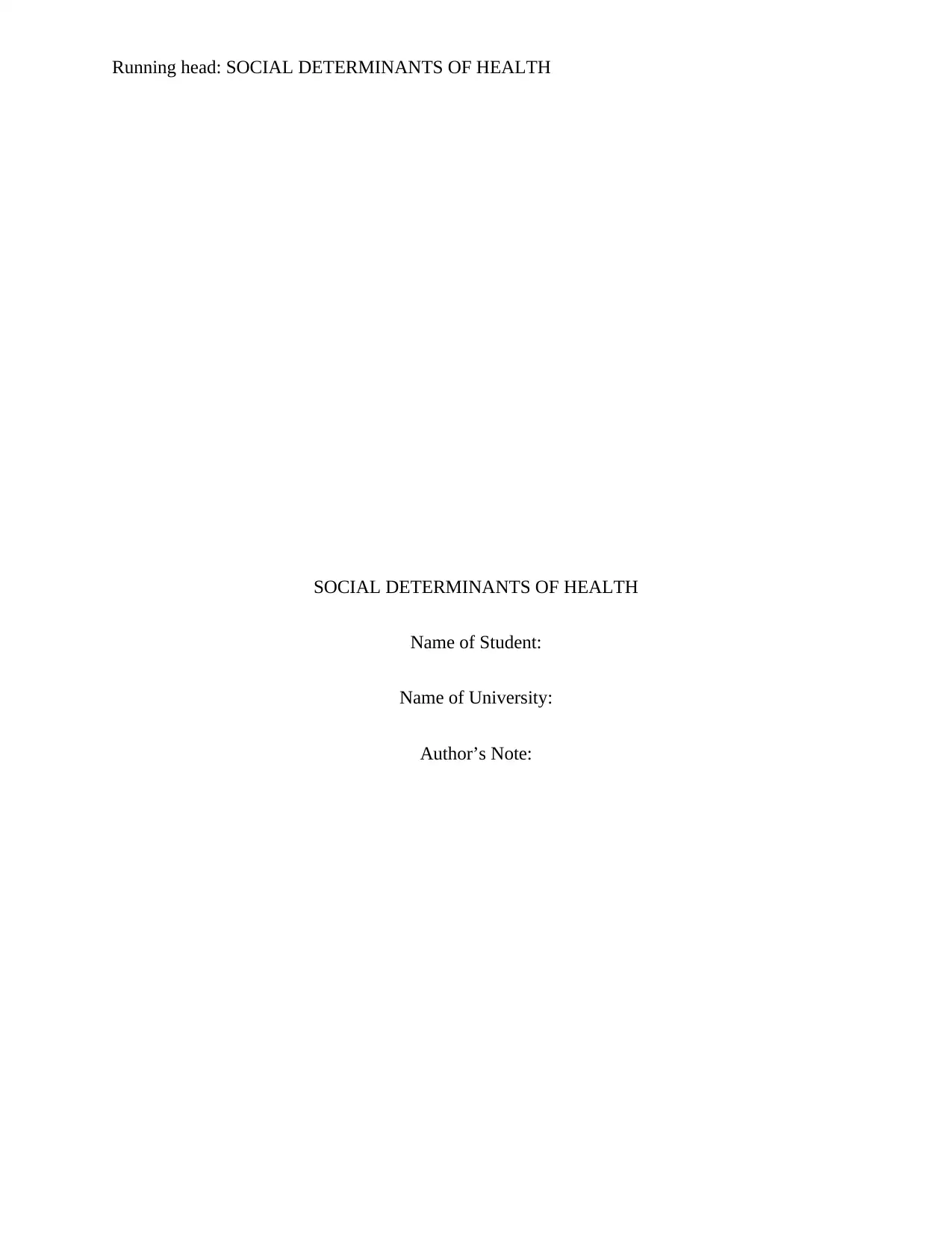
Running head: SOCIAL DETERMINANTS OF HEALTH
SOCIAL DETERMINANTS OF HEALTH
Name of Student:
Name of University:
Author’s Note:
SOCIAL DETERMINANTS OF HEALTH
Name of Student:
Name of University:
Author’s Note:
Paraphrase This Document
Need a fresh take? Get an instant paraphrase of this document with our AI Paraphraser
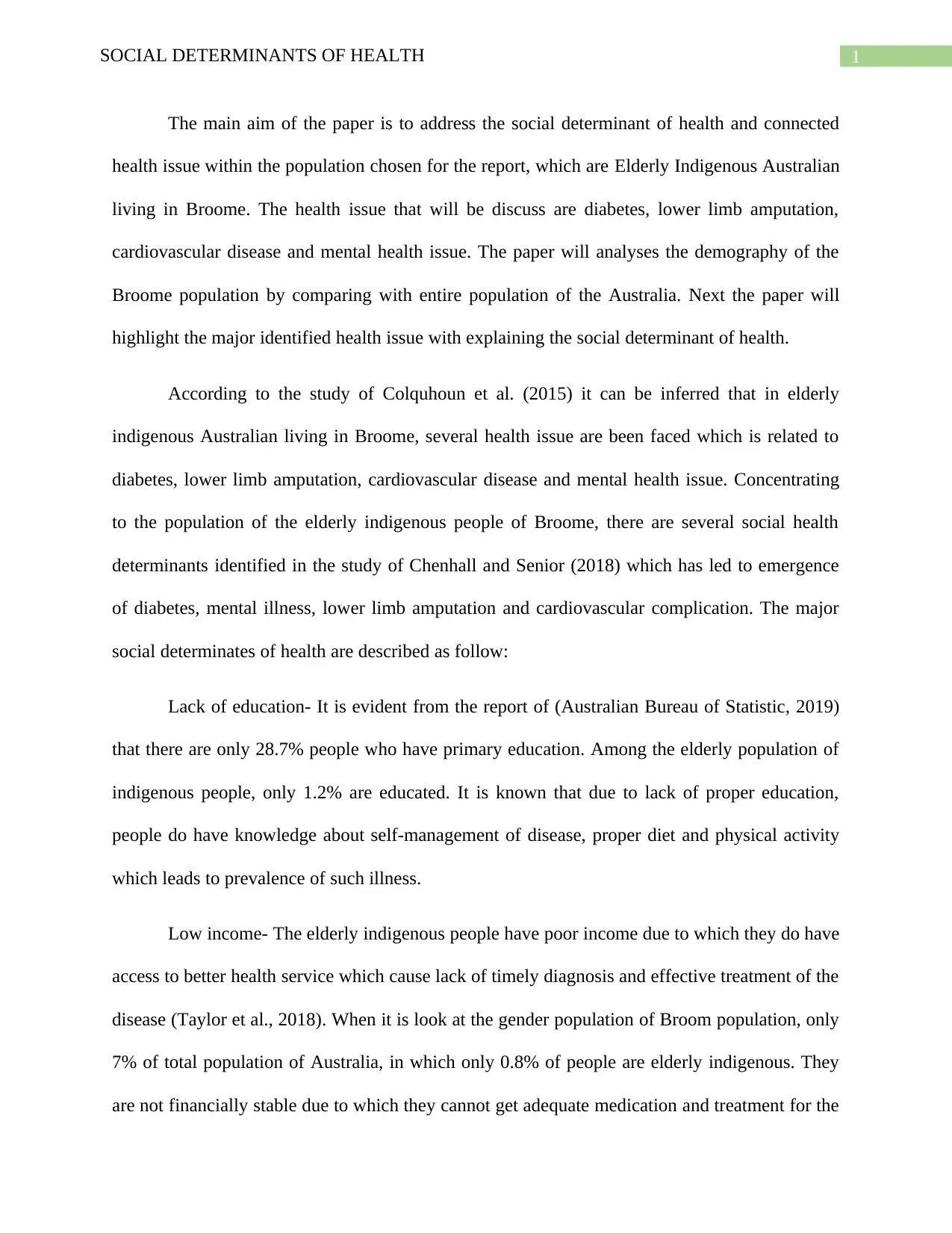
1SOCIAL DETERMINANTS OF HEALTH
The main aim of the paper is to address the social determinant of health and connected
health issue within the population chosen for the report, which are Elderly Indigenous Australian
living in Broome. The health issue that will be discuss are diabetes, lower limb amputation,
cardiovascular disease and mental health issue. The paper will analyses the demography of the
Broome population by comparing with entire population of the Australia. Next the paper will
highlight the major identified health issue with explaining the social determinant of health.
According to the study of Colquhoun et al. (2015) it can be inferred that in elderly
indigenous Australian living in Broome, several health issue are been faced which is related to
diabetes, lower limb amputation, cardiovascular disease and mental health issue. Concentrating
to the population of the elderly indigenous people of Broome, there are several social health
determinants identified in the study of Chenhall and Senior (2018) which has led to emergence
of diabetes, mental illness, lower limb amputation and cardiovascular complication. The major
social determinates of health are described as follow:
Lack of education- It is evident from the report of (Australian Bureau of Statistic, 2019)
that there are only 28.7% people who have primary education. Among the elderly population of
indigenous people, only 1.2% are educated. It is known that due to lack of proper education,
people do have knowledge about self-management of disease, proper diet and physical activity
which leads to prevalence of such illness.
Low income- The elderly indigenous people have poor income due to which they do have
access to better health service which cause lack of timely diagnosis and effective treatment of the
disease (Taylor et al., 2018). When it is look at the gender population of Broom population, only
7% of total population of Australia, in which only 0.8% of people are elderly indigenous. They
are not financially stable due to which they cannot get adequate medication and treatment for the
The main aim of the paper is to address the social determinant of health and connected
health issue within the population chosen for the report, which are Elderly Indigenous Australian
living in Broome. The health issue that will be discuss are diabetes, lower limb amputation,
cardiovascular disease and mental health issue. The paper will analyses the demography of the
Broome population by comparing with entire population of the Australia. Next the paper will
highlight the major identified health issue with explaining the social determinant of health.
According to the study of Colquhoun et al. (2015) it can be inferred that in elderly
indigenous Australian living in Broome, several health issue are been faced which is related to
diabetes, lower limb amputation, cardiovascular disease and mental health issue. Concentrating
to the population of the elderly indigenous people of Broome, there are several social health
determinants identified in the study of Chenhall and Senior (2018) which has led to emergence
of diabetes, mental illness, lower limb amputation and cardiovascular complication. The major
social determinates of health are described as follow:
Lack of education- It is evident from the report of (Australian Bureau of Statistic, 2019)
that there are only 28.7% people who have primary education. Among the elderly population of
indigenous people, only 1.2% are educated. It is known that due to lack of proper education,
people do have knowledge about self-management of disease, proper diet and physical activity
which leads to prevalence of such illness.
Low income- The elderly indigenous people have poor income due to which they do have
access to better health service which cause lack of timely diagnosis and effective treatment of the
disease (Taylor et al., 2018). When it is look at the gender population of Broom population, only
7% of total population of Australia, in which only 0.8% of people are elderly indigenous. They
are not financially stable due to which they cannot get adequate medication and treatment for the
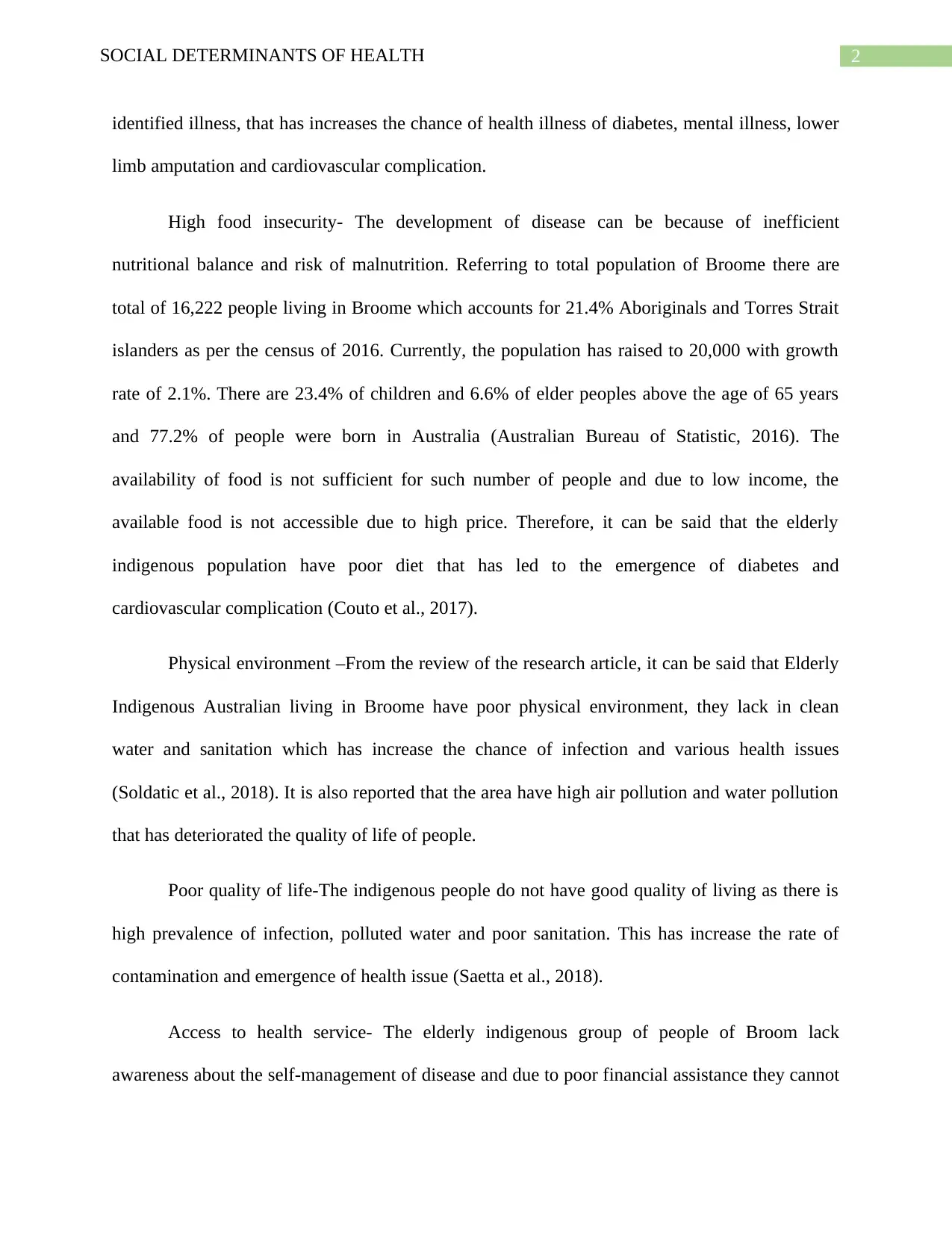
2SOCIAL DETERMINANTS OF HEALTH
identified illness, that has increases the chance of health illness of diabetes, mental illness, lower
limb amputation and cardiovascular complication.
High food insecurity- The development of disease can be because of inefficient
nutritional balance and risk of malnutrition. Referring to total population of Broome there are
total of 16,222 people living in Broome which accounts for 21.4% Aboriginals and Torres Strait
islanders as per the census of 2016. Currently, the population has raised to 20,000 with growth
rate of 2.1%. There are 23.4% of children and 6.6% of elder peoples above the age of 65 years
and 77.2% of people were born in Australia (Australian Bureau of Statistic, 2016). The
availability of food is not sufficient for such number of people and due to low income, the
available food is not accessible due to high price. Therefore, it can be said that the elderly
indigenous population have poor diet that has led to the emergence of diabetes and
cardiovascular complication (Couto et al., 2017).
Physical environment –From the review of the research article, it can be said that Elderly
Indigenous Australian living in Broome have poor physical environment, they lack in clean
water and sanitation which has increase the chance of infection and various health issues
(Soldatic et al., 2018). It is also reported that the area have high air pollution and water pollution
that has deteriorated the quality of life of people.
Poor quality of life-The indigenous people do not have good quality of living as there is
high prevalence of infection, polluted water and poor sanitation. This has increase the rate of
contamination and emergence of health issue (Saetta et al., 2018).
Access to health service- The elderly indigenous group of people of Broom lack
awareness about the self-management of disease and due to poor financial assistance they cannot
identified illness, that has increases the chance of health illness of diabetes, mental illness, lower
limb amputation and cardiovascular complication.
High food insecurity- The development of disease can be because of inefficient
nutritional balance and risk of malnutrition. Referring to total population of Broome there are
total of 16,222 people living in Broome which accounts for 21.4% Aboriginals and Torres Strait
islanders as per the census of 2016. Currently, the population has raised to 20,000 with growth
rate of 2.1%. There are 23.4% of children and 6.6% of elder peoples above the age of 65 years
and 77.2% of people were born in Australia (Australian Bureau of Statistic, 2016). The
availability of food is not sufficient for such number of people and due to low income, the
available food is not accessible due to high price. Therefore, it can be said that the elderly
indigenous population have poor diet that has led to the emergence of diabetes and
cardiovascular complication (Couto et al., 2017).
Physical environment –From the review of the research article, it can be said that Elderly
Indigenous Australian living in Broome have poor physical environment, they lack in clean
water and sanitation which has increase the chance of infection and various health issues
(Soldatic et al., 2018). It is also reported that the area have high air pollution and water pollution
that has deteriorated the quality of life of people.
Poor quality of life-The indigenous people do not have good quality of living as there is
high prevalence of infection, polluted water and poor sanitation. This has increase the rate of
contamination and emergence of health issue (Saetta et al., 2018).
Access to health service- The elderly indigenous group of people of Broom lack
awareness about the self-management of disease and due to poor financial assistance they cannot
⊘ This is a preview!⊘
Do you want full access?
Subscribe today to unlock all pages.

Trusted by 1+ million students worldwide
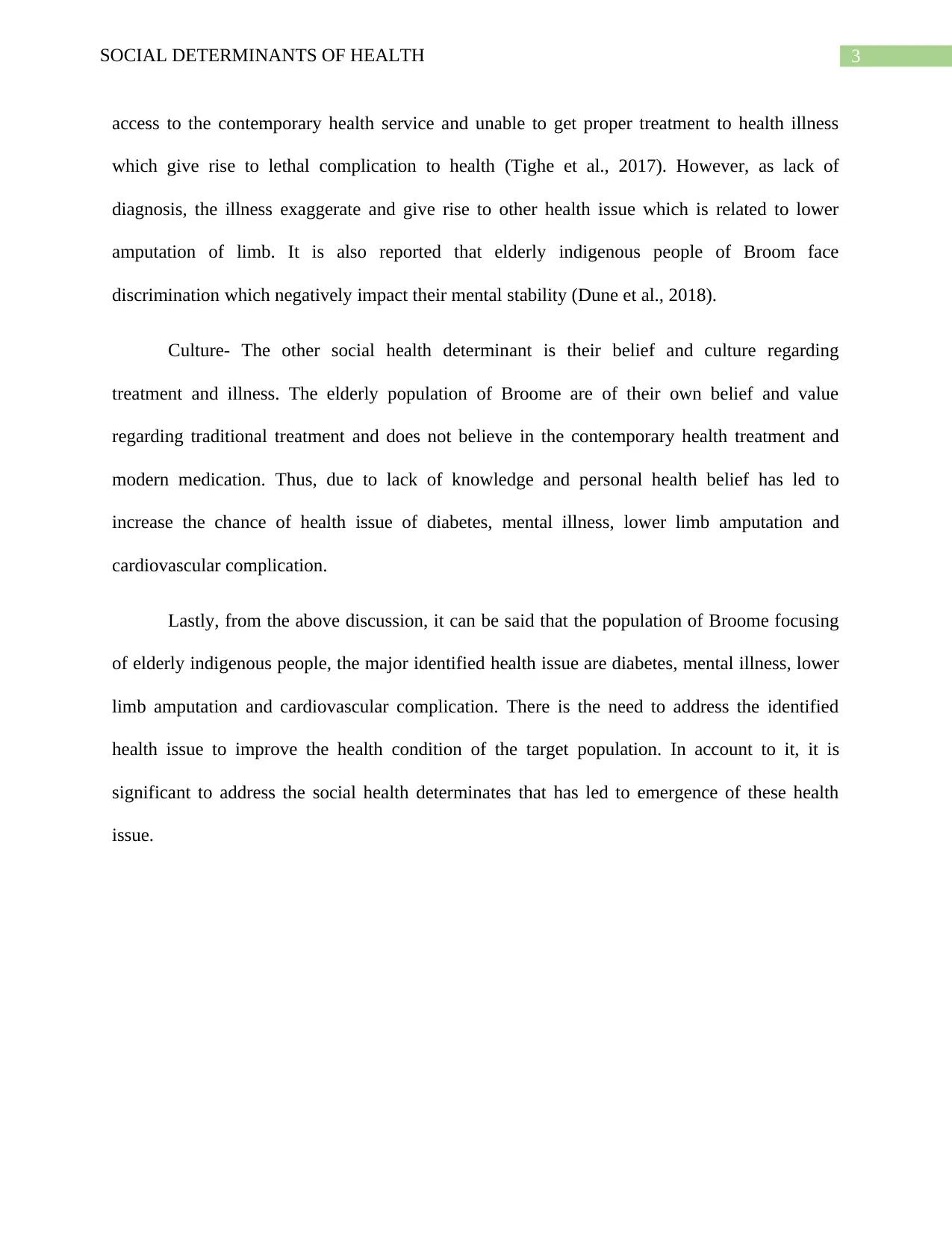
3SOCIAL DETERMINANTS OF HEALTH
access to the contemporary health service and unable to get proper treatment to health illness
which give rise to lethal complication to health (Tighe et al., 2017). However, as lack of
diagnosis, the illness exaggerate and give rise to other health issue which is related to lower
amputation of limb. It is also reported that elderly indigenous people of Broom face
discrimination which negatively impact their mental stability (Dune et al., 2018).
Culture- The other social health determinant is their belief and culture regarding
treatment and illness. The elderly population of Broome are of their own belief and value
regarding traditional treatment and does not believe in the contemporary health treatment and
modern medication. Thus, due to lack of knowledge and personal health belief has led to
increase the chance of health issue of diabetes, mental illness, lower limb amputation and
cardiovascular complication.
Lastly, from the above discussion, it can be said that the population of Broome focusing
of elderly indigenous people, the major identified health issue are diabetes, mental illness, lower
limb amputation and cardiovascular complication. There is the need to address the identified
health issue to improve the health condition of the target population. In account to it, it is
significant to address the social health determinates that has led to emergence of these health
issue.
access to the contemporary health service and unable to get proper treatment to health illness
which give rise to lethal complication to health (Tighe et al., 2017). However, as lack of
diagnosis, the illness exaggerate and give rise to other health issue which is related to lower
amputation of limb. It is also reported that elderly indigenous people of Broom face
discrimination which negatively impact their mental stability (Dune et al., 2018).
Culture- The other social health determinant is their belief and culture regarding
treatment and illness. The elderly population of Broome are of their own belief and value
regarding traditional treatment and does not believe in the contemporary health treatment and
modern medication. Thus, due to lack of knowledge and personal health belief has led to
increase the chance of health issue of diabetes, mental illness, lower limb amputation and
cardiovascular complication.
Lastly, from the above discussion, it can be said that the population of Broome focusing
of elderly indigenous people, the major identified health issue are diabetes, mental illness, lower
limb amputation and cardiovascular complication. There is the need to address the identified
health issue to improve the health condition of the target population. In account to it, it is
significant to address the social health determinates that has led to emergence of these health
issue.
Paraphrase This Document
Need a fresh take? Get an instant paraphrase of this document with our AI Paraphraser
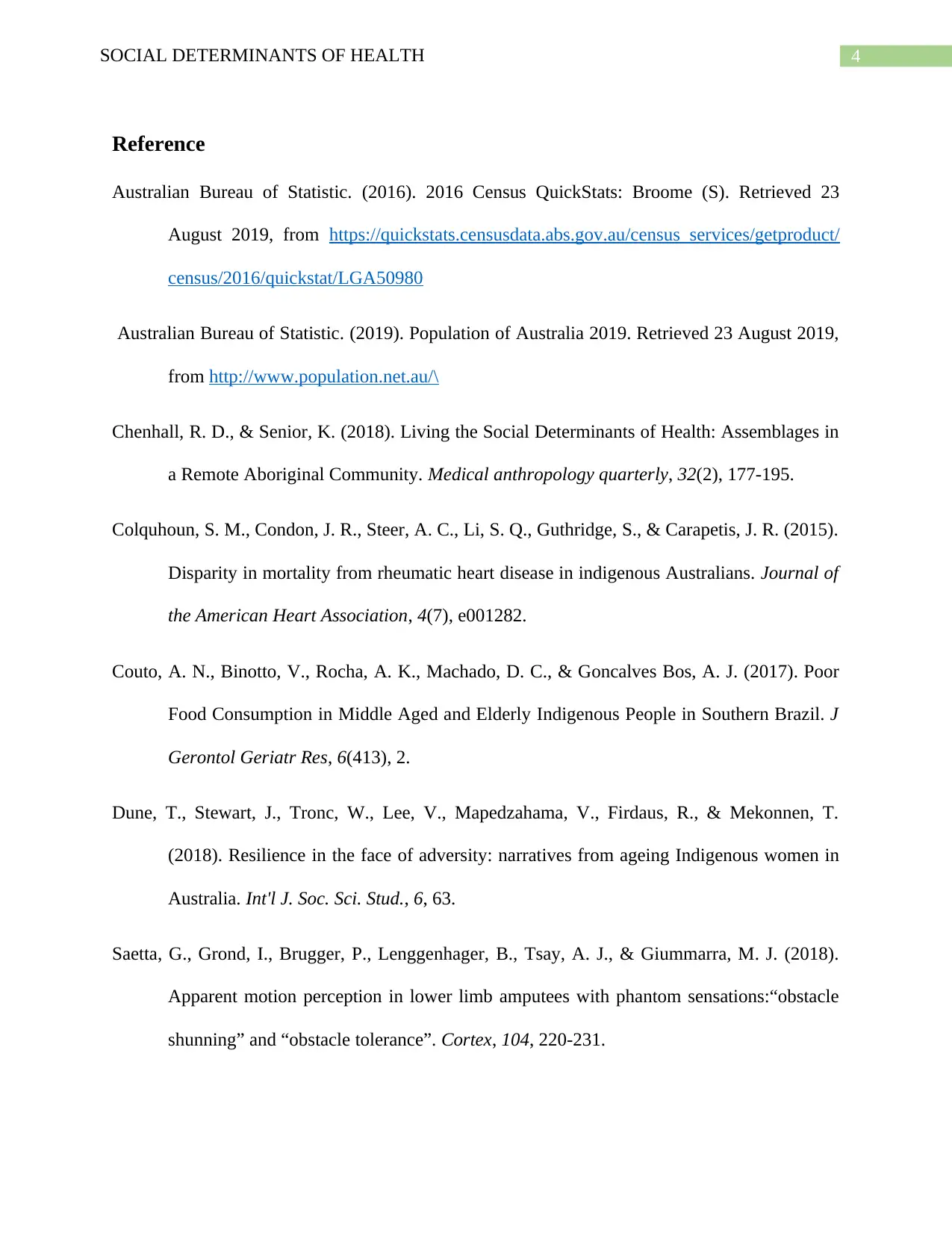
4SOCIAL DETERMINANTS OF HEALTH
Reference
Australian Bureau of Statistic. (2016). 2016 Census QuickStats: Broome (S). Retrieved 23
August 2019, from https://quickstats.censusdata.abs.gov.au/census_services/getproduct/
census/2016/quickstat/LGA50980
Australian Bureau of Statistic. (2019). Population of Australia 2019. Retrieved 23 August 2019,
from http://www.population.net.au/\
Chenhall, R. D., & Senior, K. (2018). Living the Social Determinants of Health: Assemblages in
a Remote Aboriginal Community. Medical anthropology quarterly, 32(2), 177-195.
Colquhoun, S. M., Condon, J. R., Steer, A. C., Li, S. Q., Guthridge, S., & Carapetis, J. R. (2015).
Disparity in mortality from rheumatic heart disease in indigenous Australians. Journal of
the American Heart Association, 4(7), e001282.
Couto, A. N., Binotto, V., Rocha, A. K., Machado, D. C., & Goncalves Bos, A. J. (2017). Poor
Food Consumption in Middle Aged and Elderly Indigenous People in Southern Brazil. J
Gerontol Geriatr Res, 6(413), 2.
Dune, T., Stewart, J., Tronc, W., Lee, V., Mapedzahama, V., Firdaus, R., & Mekonnen, T.
(2018). Resilience in the face of adversity: narratives from ageing Indigenous women in
Australia. Int'l J. Soc. Sci. Stud., 6, 63.
Saetta, G., Grond, I., Brugger, P., Lenggenhager, B., Tsay, A. J., & Giummarra, M. J. (2018).
Apparent motion perception in lower limb amputees with phantom sensations:“obstacle
shunning” and “obstacle tolerance”. Cortex, 104, 220-231.
Reference
Australian Bureau of Statistic. (2016). 2016 Census QuickStats: Broome (S). Retrieved 23
August 2019, from https://quickstats.censusdata.abs.gov.au/census_services/getproduct/
census/2016/quickstat/LGA50980
Australian Bureau of Statistic. (2019). Population of Australia 2019. Retrieved 23 August 2019,
from http://www.population.net.au/\
Chenhall, R. D., & Senior, K. (2018). Living the Social Determinants of Health: Assemblages in
a Remote Aboriginal Community. Medical anthropology quarterly, 32(2), 177-195.
Colquhoun, S. M., Condon, J. R., Steer, A. C., Li, S. Q., Guthridge, S., & Carapetis, J. R. (2015).
Disparity in mortality from rheumatic heart disease in indigenous Australians. Journal of
the American Heart Association, 4(7), e001282.
Couto, A. N., Binotto, V., Rocha, A. K., Machado, D. C., & Goncalves Bos, A. J. (2017). Poor
Food Consumption in Middle Aged and Elderly Indigenous People in Southern Brazil. J
Gerontol Geriatr Res, 6(413), 2.
Dune, T., Stewart, J., Tronc, W., Lee, V., Mapedzahama, V., Firdaus, R., & Mekonnen, T.
(2018). Resilience in the face of adversity: narratives from ageing Indigenous women in
Australia. Int'l J. Soc. Sci. Stud., 6, 63.
Saetta, G., Grond, I., Brugger, P., Lenggenhager, B., Tsay, A. J., & Giummarra, M. J. (2018).
Apparent motion perception in lower limb amputees with phantom sensations:“obstacle
shunning” and “obstacle tolerance”. Cortex, 104, 220-231.
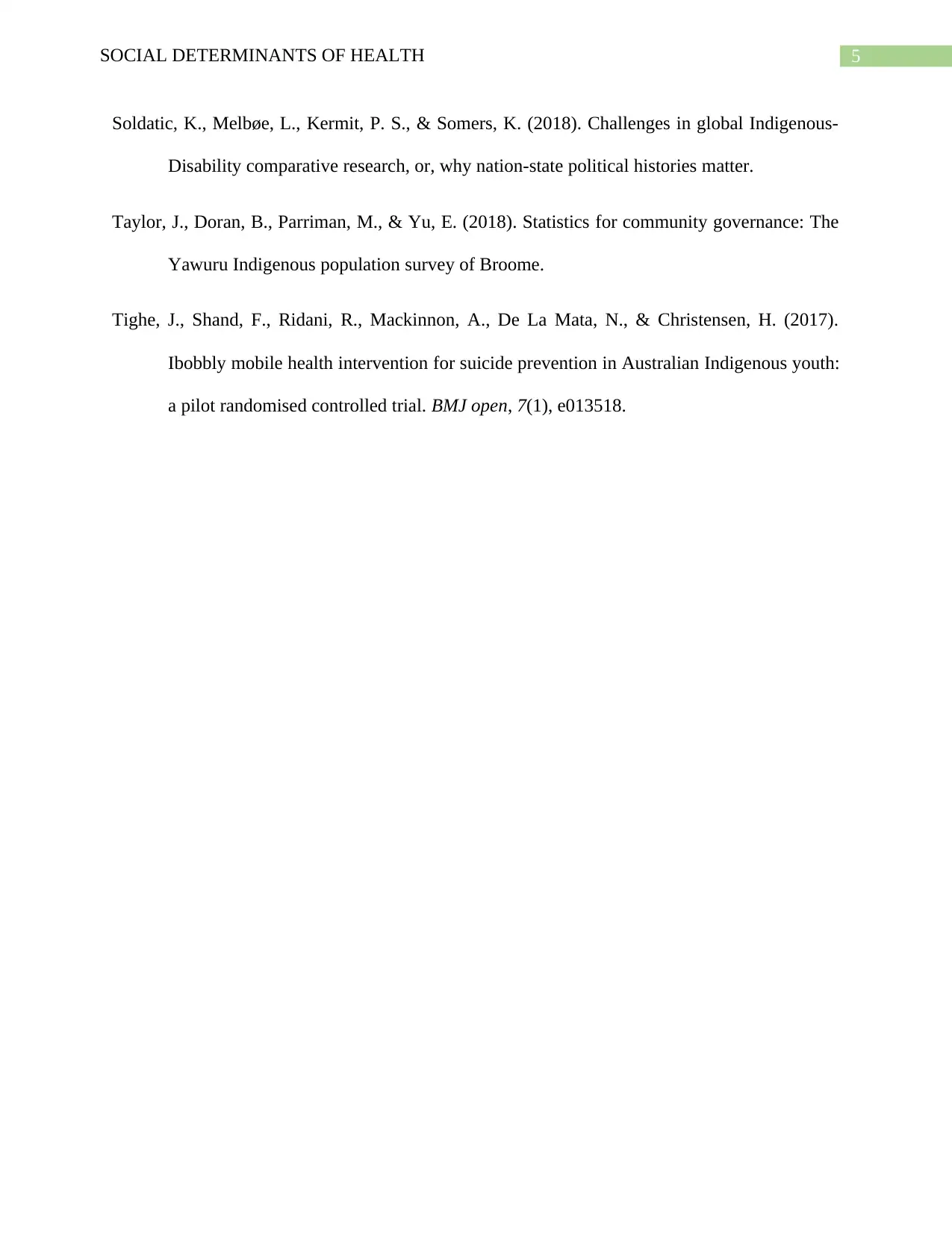
5SOCIAL DETERMINANTS OF HEALTH
Soldatic, K., Melbøe, L., Kermit, P. S., & Somers, K. (2018). Challenges in global Indigenous-
Disability comparative research, or, why nation-state political histories matter.
Taylor, J., Doran, B., Parriman, M., & Yu, E. (2018). Statistics for community governance: The
Yawuru Indigenous population survey of Broome.
Tighe, J., Shand, F., Ridani, R., Mackinnon, A., De La Mata, N., & Christensen, H. (2017).
Ibobbly mobile health intervention for suicide prevention in Australian Indigenous youth:
a pilot randomised controlled trial. BMJ open, 7(1), e013518.
Soldatic, K., Melbøe, L., Kermit, P. S., & Somers, K. (2018). Challenges in global Indigenous-
Disability comparative research, or, why nation-state political histories matter.
Taylor, J., Doran, B., Parriman, M., & Yu, E. (2018). Statistics for community governance: The
Yawuru Indigenous population survey of Broome.
Tighe, J., Shand, F., Ridani, R., Mackinnon, A., De La Mata, N., & Christensen, H. (2017).
Ibobbly mobile health intervention for suicide prevention in Australian Indigenous youth:
a pilot randomised controlled trial. BMJ open, 7(1), e013518.
⊘ This is a preview!⊘
Do you want full access?
Subscribe today to unlock all pages.

Trusted by 1+ million students worldwide
1 out of 6
Related Documents
Your All-in-One AI-Powered Toolkit for Academic Success.
+13062052269
info@desklib.com
Available 24*7 on WhatsApp / Email
![[object Object]](/_next/static/media/star-bottom.7253800d.svg)
Unlock your academic potential
Copyright © 2020–2025 A2Z Services. All Rights Reserved. Developed and managed by ZUCOL.





